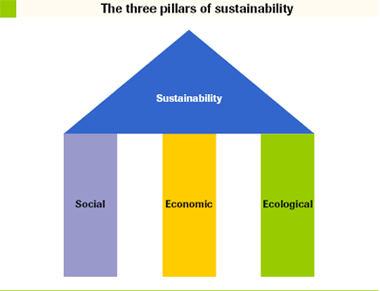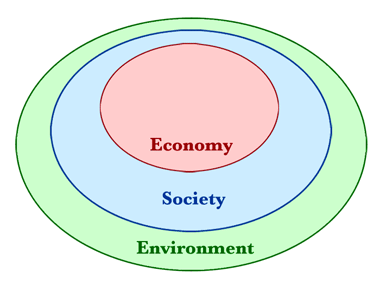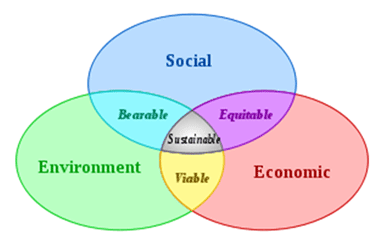What is sustainable development? The evolution of the idea
Throughout the evolution of the concept of “sustainable development” there was consensus on the fact that it does not focus solely on environmental issues. The three interdependent and mutually reinforcing pillars are: economic development, social development, and environmental protection. Indigenous peoples have argued that the fourth pillar of sustainable development is also cultural diversity.
The idea of sustainability dates back to the early 20th century in the era of industrial revolution when two opposing factions had emerged within the environmental movement: the conservationists and the preservationists. The conservationists focused on the proper use of nature, whereas the preservationists sought the protection of nature from use.[1] Put another way, conservation sought to regulate human use while preservation sought to eliminate human impact altogether.
As the first evidences of an environmental crisis began to appear, several reactions took place. The International Union for Conservation of Nature (IUCN) was founded in October 1948 following an international conference in Fontainebleau, France. Its promoter’s sought to ensure that any use of natural resources is equitable and ecologically sustainable.
The Club of Rome, a think tank composed of a small international group of people from the fields of academia, civil society, diplomacy, and industry, raised considerable public attention in 1972 with its report The Limits to Growth that predicted that economic growth could not continue indefinitely because of the limited availability of natural resources, particularly oil.
Sustainable development was a key theme of the United Nations Conference on the Human Environment in Stockholm in 1972[2]. The concept was coined explicitly to suggest that it was possible to achieve economic growth and industrialization without environmental damage.
In the ensuing decades, mainstream sustainable development thinking was progressively developed through the World Conservation Strategy (1980)[3], the Brundtland Report (1987)[4], and the United Nations Conference on Environment and Development in Rio (1992), as well as in national government planning and wider engagement from business leaders and non-governmental organisations of all kinds.
Over these decades, the definition of sustainable development evolved. The Brundtland Report defined sustainable as ‘development that meets the needs of the present without compromising the ability of future generations to meet their own needs’. This definition was vague[5], but it cleverly captured two fundamental issues, the problem of the environmental degradation that so commonly accompanies economic growth and yet the need for such growth to alleviate poverty.
The core of mainstream sustainability thinking has become the idea of three dimensions, environmental, social and economic sustainability. These have been drawn in a variety of ways, as ‘pillars’ (Figure A), as concentric circles (Figure B), or as interlocking circles (Figure C). The IUCN uses the interlocking circles model to demonstrate that the three objectives need to be better integrated, with action to redress the balance between dimensions of sustainability.

Source: http://www.vda.de/en/publikationen/jahresberichte/
B. Concentric circles

Based on "Sustainable development" diagram at Cornell Sustainability Campus: http://www.sustainablecampus.cornell.edu/csi.cfm
C. Overlapping circles

Governments, communities and businesses have all responded to the challenge of sustainability to some extent.
Almost every national government in the United Nations now has a minister and a department tasked with policy on the environment, and many regional and local governments have also developed this capacity. Since the Rio Earth Summit in 1992 the volume and quality of environmental legislation (international, national and local) has expanded hugely, and international agreements (such as the Kyoto protocol) have not only raised the profile of environmental change but also begun to drive global policy change.
Agenda 21 is a non-binding programme of action, which was adopted by more than 178 Governments at the 'Earth Summit' in 1992. Although the Agenda lacks the force of international law, the adoption of the texts carries with it a strong moral obligation to ensure implementation of the strategies. The central belief of this "global partnership" is that all countries can protect the environment while simultaneously experiencing growth.
Regarding climate change, there is increasing recognition that the impacts are being felt disproportionately by poor people who already live under precarious conditions. Climate change, with its many facets, further exacerbates existing inequalities faced by these vulnerable groups. It threatens to undermine the realization of fundamental rights for many people and to reverse progress made towards the achievement of the internationally agreed development goals, including the Millennium Development Goals (MDGs). It is a global justice concern that those who suffer most from climate change have done the least to cause it.
The concept of climate justice acknowledges that because the world’s richest countries have contributed most to the problem, they have a greater obligation to take action and to do so more quickly. However, many fear that whatever international agreement is reached between governments, it will compound the already unjust burden on the poor and vulnerable. A rapidly growing number of social movements and civil society organizations across the world are mobilizing around this climate justice agenda. Citizens from both the South and the North are drawn to this concept, in part, because many are already experiencing the impacts of climate change and they worry about the fate of their families, homes and livelihoods[6].
The ‘greening’ of business has grown to be a central issue in corporate social responsibility for many global companies, although for many it is still a boutique concern within wider relationship management, rather than something that drives structural change in the nature or scale of core business.
Since the Earth Summit in Rio de Janeiro in 1992 and the World Summit on Sustainable Development in Johannesburg in 2002, the subject of sustainable development has moved up on the political agenda. However, action is still not matching the many challenges such as climate change, poverty alleviation and biodiversity loss. Inequality is growing in the world, and the multiple global crises make it all the harder to advance the sustainability agenda effectively and to secure genuine global co-operation and partnership on the key issues.
In the light of the new and immense challenges faced by the sustainable development agenda, there were calls from many countries and stakeholders for a new World Summit in 2012. The initiative, started by President Luiz Inácio da Silva of Brazil was supported by a large variety of countries and stakeholders including the United Nations General Assembly that decided in a 2009 Resolution A/64/236 that a UN Conference on Sustainable Development will be held in 2012 in Rio de Janeiro, Brazil.
has offered to host this Conference, 20 years after it hosted the landmark 1992 UN Conference on Environment and Development attended by Heads of State and Governments (the “Earth Summit”).
Twenty years after the landmark Earth Summit, the objective of the 2012 Conference is “to secure renewed political commitment for sustainable development, assessing the progress to date and the remaining gaps in the implementation of the outcomes of the major summits on sustainable development and addressing new and emerging challenges. The focus of the Conference will include the following themes to be discussed and refined during the preparatory process: a green economy in the context of sustainable development and poverty eradication and the institutional framework for sustainable development”[7]
[1] Akamani, K. "The Wilderness Idea: A Critical Review." Retrieved: April 21, 2006. http://edu4sd.blogspot.com/2006/04/wilderness-idea-critical-review.html
[2] McCormick, J.S. (The Global Environmental Movement: reclaiming Paradise, (London: Belhaven, 1992).
[3] IUCN, The World Conservation Strategy, (Geneva: International Union for Conservation of Nature and Natural Resources, United Nations Environment Programme, World Wildlife Fund, 1980). WWF is now the Worldwide Fund for Nature, IUCN now the World Conservation Union - IUCN.
[4] B Brundtland, H. Our Common Future, (Oxford: Oxford University Press, for the
World Commission on Environment and Development, 1987), (p. 43).
[5] S.M. Lélé, “Sustainable development: a critical review,” World Development 19
(1991): 607-621.
[6] NGLS, Climate Justice for a Changing Planet: A Primer for Policy Makers and NGOs, December 2009: http://www.un-ngls.org/spip.php?page=climatejustice
[7] paragraph 20(a) of the Resolution.


